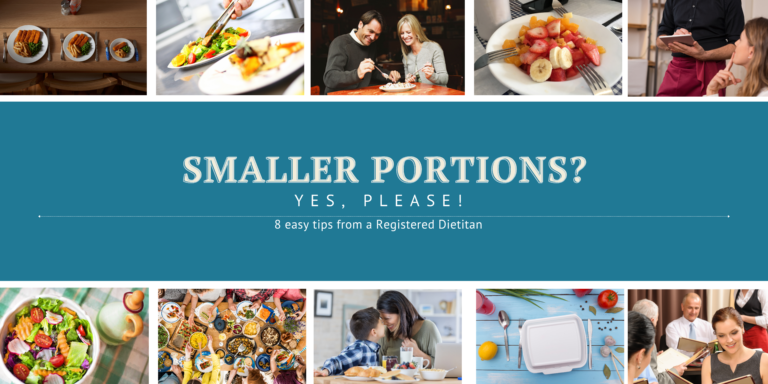Portion Control
8 Tips from a Registered Dietitian

Portion control: Portion size versus Serving size
Are you trying to figure out healthier portion control at meals? But, you find yourself confused between what a serving size and a portion size are? Well, so do most people.
Portion size is the amount of food you are offered and eat in one sitting.
A serving size is an amount that we should eat in one serving.
Portion control is finding the balance between the serving size (which is typically smaller than we want) and the portion size (which is typically larger than what we should eat in a sitting).
Why are we eating more, without realizing it?
There is vast confusion and misinformation surrounding portion control. The serving size of foods is found on the nutrition facts label and is considered a ‘healthy’ serving size. However, in contrast, portion size does not consider the serving size and is often much larger than it needs to be. Americans are eating more food than ever before. Restaurant meals, snack bags, and beverage containers are bigger than ever. As an example, restaurant meals and fast-food meals have increased in size by 138% in the last 40 years, while bread and pasta dishes have doubled in size in the same time frame (1).
Additionally, it isn’t easy to find a single-serve container/bag/package of any snack food anymore. If you look around, food is sold as ‘shareable’, ‘family-size’, sharing size, and so on. In the end, all this extra food and packaging is increasing our waistlines, has doubled the incidence of obesity, and increasing our risk of a multitude of chronic, preventable diseases. However, there are a lot of easy fixes to trick your eyes, stomach, and appetite into eating more moderate portion sizes, improving your portion control, preventing overeating and feeling satiated after a meal, rather than stuffed and exhausted.
8 tips for easy portion control
- Use smaller plates. An appetizer plate is appropriate for meals, rather than a dinner plate, which has grown from 7-9 inches to 12-13 inches(2).
- Fill your plate with veggies/salads and fruit options first, then fill in with the protein and grain foods. You will be surprised how this reduces the size of your main entree!
- When buying snack foods, only buy your snack food of choice in a single serving size container. This can be a challenge and the food even more rewarding if found.
- Similar to plates, use smaller glasses for your drinks at mealtimes.
- Drink an 8-ounce glass of water before every meal. The water helps take up some room in your stomach and may help you to feel full sooner.
- When eating out, order an appetizer as your main meal OR split the main entree between two people, OR immediately box up half an entree to take home.
- Ask to substitute standard sides with a meal such as potatoes, fries, or rice with a side salad, cooked veggie, or fruit.
- Order your meal from the child’s menu when ordering at fast-food restaurants.
What will you choose?
What will you choose? All of the above suggestions result in smaller portion sizes and better portion control and healthier waistlines without the feelings of deprivation, hunger, and guilt that often come with overeating. Choose one of the tips above next time you eat. Let me know what you think! Have another idea? Share it on my socials.
